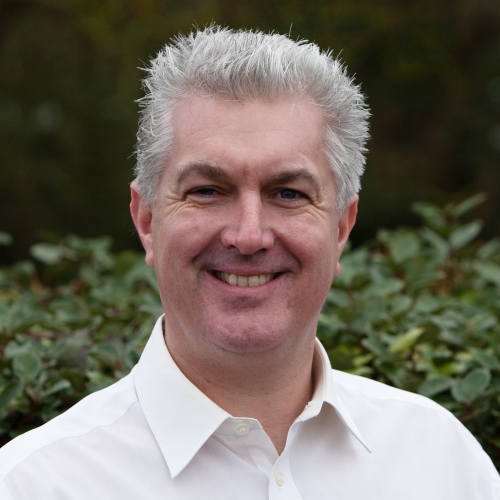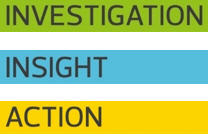The Presentations given by Richard Payne and John Bushell of SPORTS MARKETING SURVEYS INC. on Wednesday 18th July 2018 at the Golf Industry Lunch hosted jointly with the British Golf Industry Association on behalf of HSBC Golf Roots
Richard Payne
Good afternoon ladies and gentlemen, I am delighted to once again have the honour of welcoming you all to the Open Industry Lunch on behalf of SPORTS MARKETING SURVEYS INC.
John and I are delighted to welcome you to Carnoustie for the 147th Open Championship, the 8th to be hosted here on what many regard to be the toughest of The Open courses. I think that you’ll agree that the Claret Jug pavilion is a stunning location for this year’s lunch with a view down the hole that will crown the Champion Golfer of The Year and the infamous Barry Burn which will no doubt play its part in history before the week is out.
This is the ninth lunch hosted by SPORTS MARKETING SURVEYS INC. and the BGIA on behalf of HSBC Golf Roots; and it wouldn’t be an SMS speech without continuing the tradition of once again welcoming Paul Jepson and Ian Peacock who are both attending their 33rd Sports Marketing Surveys Open lunch. This is a tradition that we are delighted continues.
A lot has happened over the past 12 months since we were all together at Birkdale – from Justin Thomas and Patrick Reed winning their first majors; to Djokovic, Federer and Nadal reasserting their dominance on the tennis court and winning the four grand slams between them; and England getting so close to ending over 50 years of hurt and nearly “bringing it home!”

Maybe not as momentous, but there have also been several developments and exciting projects conducted at SMS INC.; ranging from global studies that will affect the future of golf including the USGA & R&A research into the Rules Modernisation and World Handicapping System through to the first detailed study in several years conducted amongst PGA members and continued programmes of research with federations and manufacturers in golf and across the sporting world.
Our online and social media analysis tool, SMS INC RADAR has enabled us to gather immediate and more varied insight into multiple topics from Johnnie Walker’s JOIN THE PACT (no drink driving) campaign launched at the British Grand Prix to analysing the social commentary around the second year of Golf Sixes.
So here we are back at THE OPEN and at Carnoustie, the course famous for the sublime and the ridiculous, where Ben Hogan mastered the 6th hole to have it renamed after him and, of course, where Jean Van de Velde famously stripped off his FootJoys to climb into the Barry Burn.
It is 12 months since Jordan Spieth conquered Birkdale, including parts of the course that no one realised would be in play, to become the champion golfer of the year and 12 months in which we have seen all 4 majors won by Americans!
But what has been happening at the coal face of the sport in the last year in GB? Well much like Van de Velde’s 18th hole exploits, I’m afraid to say the picture isn’t a pretty one. We debated whether or not to just skip over these figures for today’s speech but in the interest of being an independent provider of the facts and figures we can’t hide from the fact that Rounds Played for the second half of 2017 were down 6% compared to the same period in 2016 and that this downward trend continued into the first quarter of 2018, with possibly the worst weather conditions resulting in rounds being over 20% down compared to Q1 2017! The light at the end of the tunnel is that our provisional figures would show that this June was almost 6% up compared to 2017 but we need a fair wind for the rest of the year to steady the ship. Rounds played and levels of participation often go hand in hand and, unfortunately this is another area where another year of decline has seen the number of British adults who have played the game at least once on a full length course drop to just over 2.5 million, the lowest figure recorded in over 20 years.
Now, I appreciate that it is hard to see how there are any positives from those figures but diving deeper into the numbers, we can see that the number of core golfers, those that are the lifeblood of the game and account for around 80% of equipment purchases, has fared better and the frequency with which the avid golfer is playing has actually increased. So this would suggest that golf, for golfers, is not broken but more needs to be done to widen its appeal.
And this is where I feel there should be great optimism for our sport. You don’t have to look far beyond this room to see some of the great work that is taking place in this area, from the global success of TopGolf and TopTracer encouraging people that a driving range is FUN to the European Tour’s successful staging of the second Golf Sixes. That event not only showcased that there are alternative ways to play golf on a course but also widened its reach by becoming a mixed gender event which in turn has led to the formation of the Golf Sixes league. There is also The Women In Golf Charter that was launched by The R&A back in May, which is a clear declaration that golf is inclusive, that we want more ladies in all facets of the game and that we are going to change the whole perceived culture to ensure everyone is made to feel welcomed.
Finally, please just let me finish by saying that golf is a Sport for Life and should be celebrated as such. A recent study that we conducted for The R&A highlighted that golfers feel less lonely than the average population, we feel more engaged with our local community, we feel less stressed and we are generally happier in our everyday lives, so let’s continue to push golf’s positive messages, continue to widen the appeal of the sport and get more people smiling!
John Bushell
Thank you, Richard, for giving us a run through of the state of golf – and some of the issues and opportunities facing the sport.
As Richard mentioned, here we are in Carnoustie for the 8th time the venue has hosted THE OPEN, 496 miles from SMS INC.’s Wisley base, or, in other words, 2,754 average Rory McIlroy drives – assuming he does not tire when he gets to 2,000. Still, it is better than the 6,500 miles that fans of Russian second division football side Baltika Kaliningrad had to travel to watch a 0-0 draw against Luch Vladivostock this March.

As we are in Scotland it seems only right to take a moment to remember some of Scotland’s sporting triumphs from the last year. Chiefly, the last year is notable in Scottish sport for some famous victories against the Auld Enemy – England.
Scotland’s Calcutta Cup win was their first Six Nations victory over England for a decade – and only the fourth since the famous Grand Slam at Murrayfield in 1990 when David Sole, Lions and Scotland Captain walked out the Scotland team. Why is this interesting? Well, just last month, Scotland ‘s cricketers enjoyed their biggest ever win, scoring 371-5 to beat England, the highest ranked ODI team in the world at the Grange – averaging 7.4 runs an over, and with Chris Sole – David’s son being one of the key Scottish Players.
Although 2017 was a frustrating year for Scotland’s pre-eminent sportsman Andy Murray, his brother Jamie teamed up with Martina Hingis to win two tennis Grand slams of his own.
Meanwhile Scottish Athletes accounted for 17 of the 59 athletes that made up the Team GB Winter Olympics Squad in PyeongChang in South Korea in February. In summer sports, Scotland enjoyed their best overseas result at a Commonwealth Games in April 2018 on Australia’s Gold Coast – winning 44 medals and 14 more medals than targeted.
So, whilst Scotland has had a good last 12 months – it seems fitting to turn to a country that has enjoyed perhaps an even better year -– France. 2018 has seen – or will see – France……
- Awarded the Olympics Game in Paris for 2024
- Win the FIFA World Cup on Sunday against Croatia
- Hosting the Ryder Cup in September at Le Golf National
This gives me a chance to welcome Celine Prevost from the FFG to the lunch today, and to wish her team a fabulous event. As of this week, there are 8 Americans and 9 Europeans in the Top 20 males golfers in the World, and whilst 2016’s Ryder Cup stopped a run of 4 back-to-back European victories, Thomas Bjorn’s team will be an exciting prospect for us all.
Female Participation
However, I would like to take a minute to focus on women’s sport. For so long an untapped area in the sporting world, whether in marketing, in professional coverage or even as targets for research, women’s sport has come a long way in a short space of time.
You have to go back less than 100 years to find a quote from the FA to the effect that “the game of football is quite unsuitable for females”. In cricket, Lords only staged its first female game in 1976 – after Rachael Heyhoe Flint threatened to take the MCC to the Equal Opportunities Commission.
Whilst such attitudes are not universally consigned to the rubbish heap they are moving in the right direction. As many social media commentators were keen to point out, the 2018 FIFA World Cup Semi Final was not, strictly speaking, England’s first for 28 years, but rather for 3 years, since the women reached the last four in Canada in 2015.
Just as the Great Britain ladies’ hockey team became national darlings at the 2016 Olympics, 2018 was the turn of the England Netball team who won Commonwealth gold against the traditionally dominant Australian side, it was The Roses success in a thrilling 52-51 victory that came down to the last play of the Final in April. That progress echoes the health of a sport that saw a 44% increase in female netball participation in 2017, and is one of a number of reasons why more and more clubs, events, manufacturers and sponsors are turning to women’s sport to tap into new audiences.
More female sports-players means a growing demand too for female products and coaches. Our soon to be released European Tennis Report for Tennis Europe reveals improvements in the male/female balance of tennis coaches across Europe. From grass roots, to professional sport, and at all the layers in between, the tides of women’s sport are rising.
Underlining how much has changed since the likes of Baroness Heyhoe Flint fought for a first women’s cricket match, 2017 saw a sell-out crowd attend Lords to watch the women’s World Cup final when England defeated India by 9 runs. In football, the Women’s European Championship final attracted a crowd of 76,000 for the Netherlands victory. Continuing the female football spin, in the UK, a new semi-professional second tier of the game launches in 2018 including Lewes FC who are the first football club in the UK to adopt a policy of equal pay for their men’s and women’s sides.
Wimbledon And Tennis
This summer has seen the FIFA World Cup dominate the sports media – across all channels – that it has been easy to miss some of the regular fixtures of the sporting summer – whether England winning 5 consecutive One Day internationals against Australia, or even the Wimbledon Championships.
Tennis is important to SMS INC. and this year, we have been fortunate to have our relationship extended with Roland Garros and the FFT around their Championships. We also extended our Wimbledon Equipment Census Contract with the All England Club to 2020. 2019 will mark 35 consecutive years of the programme – and we will have identified around 30,000 players racquets, shoes, bags and apparel. I traditionally unveil the winner of the count at THE OPEN, and whilst we saw Novak Djokovic win his 4th Wimbledon with a Head racquet against Dunlop-Srixon wielding Kevin Anderson – it was Wilson which was the number one racquet in play across all competitions.
Our Tennis Europe, Member Nations programme shows if Tennis were a country in Europe, it would be the 10th largest country with 25M players, sandwiched, in population terms, between Poland and Romania.
Yet, perhaps the most remarkable story at Wimbledon this year was the return of Serena Williams aged 37 and world ranked 181 – who lost the ladies final to Angelique Kerber, and this only 10 months after giving birth. Serena’s was an awesome and inspiring performance for all parents.
But there is a cloud for the sport. Racquet sales have dipped with only 2.1M shipped in 2017 in Europe, and more worryingly in the United States, where shipped sales are down 42% between 2009 and 2017 in the world’s largest tennis market.
Let’s return to the 2018 FIFA World Cup
It was a great FIFA World Cup – there are two facts that you might have missed that caught my eye.
- There was only one nil-nil draw in the whole Tournament which was in the early Group stages in June between Denmark and France;
- Whilst Harry Kane may have won the Golden Boot, it was Kylian Mbappe that caught most of the attention. This star was made – and in scoring in the Final – he became the first teenager to achieve this since Pele in 1958.
The Jules Rimet trophy may not have come home but in another sense football did. Gareth Southgate took a young, unheralded England side to the World Cup semi-finals, overcoming England’s penalty hoodoo, and rebuilding bridges with fans and the media, and waistcoat salesmen in the process.
Yet it was as much the way that they lost as the way that they won that reinvigorated faith in the national side. Classy, eloquent, open and complimentary in defeat, England reminded us that sport is about enjoying the journey, whether that be as a fan or as a player, just as much as it is about the final destination. By doing so they managed to ensure that their exit was one that promises to be the first chapter of a new journey rather than the last chapter of an old one.
That message, that sport is a lifelong journey was made very clear in a programme of recent research for The R&A on golf as ‘A Sport for Life’. Richard has alluded to this briefly, and I am pleased to say the R&A has allowed me to broadcast some of the key claims for the first time. I would like to finish with these fabulous facts – so listen carefully:
- 72% of golfers consider themselves to be in ‘good health’ compared to 51% of the general population
- 80% of golfers are happy with their social life compared to 60% of the general public.
- A third more golfers feel engaged with their local community compared to the national population.
- Golfers are two and a half times less likely to be at risk of social loneliness or to be amongst socially lonely than the national population.
- Golfers are two and a half times less likely to describe themselves as anxious than the general population.
- Almost 4 out of 10 non-golfers would consider going to their local golf club for non-golf activities.
These figures, along with the many others arising from the report, paint a truly astonishing portrait of the power of golf. There are huge opportunities to tell more people about the sport that we are here to celebrate, from the 16-34 year olds surveyed who were the age group most likely to consider social memberships, through to pre-tirees and pensioners for whom golf can offer vital mental and physical wellbeing benefits. The golf club can be the hub of the community for golfers and non-golfers – driving usage and revenues to the sporting infrastructure.
These benefits are independent of medal winning or handicap lowering. The government & the medical fraternity – with the issues on social care and healthcare in society – should be doing more to harness this positive power of golf for society’s overall healthy future. Much like England’s World Cup odyssey, it is the golfing journey that is important, winning, losing and everything in between.
Thank you for your time and have a great week at the 147th OPEN here in Carnoustie.
 SPORTS MARKETING SURVEYS INC.
SPORTS MARKETING SURVEYS INC.
The Courtyard, Wisley, Surrey GU23 6QL, UK
Tel: + 44 (0) 1932 345 539
JOHN BUSHELL | MANAGING DIRECTOR
john.bushell@sportsmarketingsurveysinc.com
www.sportsmarketingsurveysinc.com

